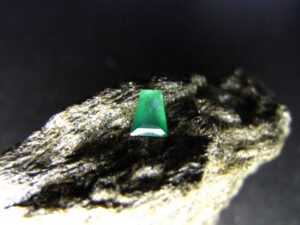
Although the occurrence of Emeralds in this high alpine valley is the only relevant one in Europe, it is of almost no importance in today’s international market. Most likely you will see an Austrian emerald in your everyday work. But since there have been periods in time where the Habachtal emeralds were one of the few known sources for this magnificent gem species, the possibility of encountering an Habachtal emerald in antique jewelry and art pieces is present. I want to draw the attention of the members of the industry for a closer look on emerald objects that meet some of the criteria I will list further down below.
General Overview
Through the fact that the emerald-hosting rocks are situated in 2.000 to 2.200 m above sea level in extremely steep mountains, it was not possible to establish a regular underground mine for a very long time. Thanks to climate change the actual primary deposit nowadays is free of ice for about 4 – 6 months a year. In history, there were phases where mining was impossible due to snow and ice coverage as well as phases where the average temperature was 2 degrees Celsius above the one of today.
Avalanches, rolling stones, missing street connections, landslides, and high flash floods always kept people away from this area, which nowadays is a national park called “Hohe Tauern”.
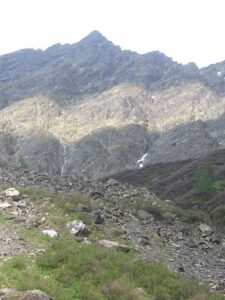
The first bigger international appearance of Habachtal emeralds was in 1861 at the London World Industrial Exhibition. The stones were so beautiful that a Viennese jeweler invested a lot of money in opening a mine up there. He was successful, one of the gems he mined in that period was 42 carats after cutting and is now mounted into the English crown jewels. My ongoing inquiries to get some more information and pictures of this famous emerald haven’t been answered so far.
Later on, an English company (Esmerald Mines Ltd.) took over the operations for about 20 years, and the stones they mined in that period (There are only figures for one year left in documents: in the 1903 season they sent 32.000 Carats of fine rough and 7.000 Carats of excellent quality to England) were labeled as “Indian emeralds” because the deposit was not known to most of the people in gem trade and would have sold for a much lower price.
The first world war (England and Austria were opponents) set an end to that profitable mining period. Before the English were forced to leave, they blew up the so-called “emerald breast”, a geological formation within the mine were the best gems were found. This rich mother lode is still undetected nowadays, which adds another piece of puzzle to the myth of Habachtal.
None of the following mining operations ever repeated the success of the English period. Since the mine is in a national park, the authorities only allow methods of mining that are harmless to the environment. No machines (except a generator for electricity to light the tunnels) are allowed and they are only allowed to extract 50 cubic meters of mother rock per season. Everything must be done by hand. Most pieces were and are sold as mineral specimens. The family that runs the mine today generates good money with these specimens, but only about 20 to 50 emeralds per year are clean and big enough to match up with the best Colombian gems.
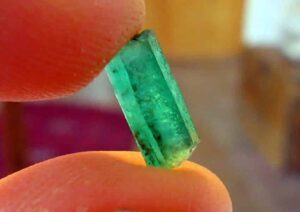
Here is another interesting difference to international emerald market: all cut and polished emeralds from Habachtal are sold for triple (Poor qualities) to quadruple (The best gems) the price of comparable Colombian material. These high prices are paid by European collectors, one can compare that to the similar situation in other gemstone deposits, for example the Blue Sapphires of Montana, USA.
Some people tried to take advantage of this fact and imported cheap rough from other mines around the world to sell them as Austrian emeralds. Due to the identical geologic environment especially the emeralds from the Tokowaya mine near Sverdlovsk in the Russian Urals were used to imitate Austrian specimens. These betrayals were uncovered very fast, since the inclusions of Austrian emeralds make them easily identifiable for gemologists.
Timeline Habachtal Emeralds
| Time | Comments |
|---|---|
| 800 BC – 300 AD | Emeralds were picked out of the river gravel by Celtic ore seekers that were active in the area. They mainly prospected for copper and iron ores, quartz crystals and emeralds were a byproduct of that search, but probably not mined for in that period, although pieces did show up in civilisations that were trading with the Celts. |
| Around 500 BC – 70 AD | The findings of emerald jewelry and loose crystals in the ruins of Pompeii and Herculaneum has led some scientists to the assumption, that the Habachtal mines were producing higher quantities of rough stones in this period. These assumptions are, although based on evidence, not yet proven. |
| 23 AD – 79 AD | Plinius the elder reports that there are three sources for emeralds. Besides the Egyptian mines of Cleopatra near Marsa – Alaam and the ones in the Afghanistan/Pakistan border region, he writes of emeralds “in the mountains of the Scyths”. |
| 1260 – 1270 | The famous St. Louis Emerald, a 51,5 ct. Square emerald cabochon mounted into the Holy French Crown has proven to be of Habachtal origin. It is also of interest that the gemstone, due to it´s cut, points to an earlier period. The square flat cabochon of this style was used in the jewelry of the Romans. |
| 1400 – 1650 | There is evidence that indicates a possible mining of emeralds under the supervision of the Archbishops of Salzburg. This evidence is mainly based on a report by E. Gübelin who appraised jewelry containing large emeralds that was said to be inherited from this source. The author is investigating the matter intensively, but the assumption is not proven yet. |
| 1665 – 1795 | The “Hochfürsthliche Cristallmühle” in the province capital of Salzburg was a gemstone and crystal cutting workshop that built many impressive pieces of art, mainly for the archbishops but pieces originating from here were highly sought after especially by north Italian aristocracy. |
| 1669 | First written document mentioning “Emerald mines in Tyrol”. |
| 1797 | Caspar Melchior Schroll gives the first mineralogical description of Habachtal emeralds. |
| 1812 | The french cleric and scientist Abbé Hauy, the founder of modern mineralogy, describes the emerald as a mineral for the first time. Before that all kind of green stones were named emerald. One of the two emerald crystals out of his collection proved to be of Austrian origin. |
| 1861 | The Viennese Goldsmith Samuel Goldschmitd buys the area and starts a mining operation. after his death in 1871 no one is really interested to take over the mine that consists of two buildings and 4 shafts. |
| 1896 | The English company “Limited Forster” from London successfully revives the mine. |
| 1903 | The English company “Esmerald Mines Ltd” takes over and successfully operates the mine. Documents from 1903 show a production of 68.000 Carats in that year. |
| 1913 | In the dawning of WW I the English leave the mine, but also destroy the most productive underground area, the so called “emerald breast” by a big blast. |
| 1917 – 1923 | Anton Hager, a sawmill owner from Traunstein /Bavaria operates the mine until 1923. The operation ate all his capital and he dies as a poor man. |
| 1929 | The newly founded “Deutsch – Österreichische Edelsteinbergwerksgesellschaft” from Zug / Switzerland tries to operate the mine – and goes bankrupt in the same year, the year of the great depression. |
| 1929 – 1953 | The depression and the following catastrophe of the Second World War leads to the decay of the mine. Many adventurers, betrayers and thieves enter the mine and some of them leave with big amounts of valuable stones. Illegal use of explosives destroy parts of the tunnels. |
| 1945 – 1959 | The German officer Oberst Hans Zieger hides in the mine because he fears to be detained by the American authorities as a high rank member of the Wehrmacht. He later is set in as the legal guard of the mine by its owner, Dr. Gaab, an attorney at law from Munich, Bavaria. Zieger mined many beautiful emeralds and cut and polished them with a self built machine directly at the mine. He dies due to the radioactivity of the environment he lived in for years. |
| 1959 – 1975 | The mine once again is a magnet for all kinds of obscure individuals. In the later part of the period Robert Eberl and Anton Caha try to establish a mine accessible for the public by selling one day prospecting permits for the greater area to finance the rebuilding of the tunnels. |
| 1975 – 1986 | The mine is leased to Sebastian Berger. He is a professional explosives specialist and the first season of his operation brings out huge amounts of beautifully colored emeralds. He had hit a pocket, similar to the one that was mined by the English decades before. He sold 470.000 DM worth of emeralds at the Munich Mineral Show the same year. Unfortunately he was mentally ill, and his paranoia led to a climax in 1986: after building a nuclear bunker in his backyard with the profits of the mine, he shot his wife and committed suicide. Before he did that, he, like the English before him, set off a blast in the most productive zone of the mine to seal it forever. The Berger period was the most productive since the English, many of the mined gems rival the finest of Colombian origin. One piece the author was able to see once (but not allowed to take a picture of) is a 14 cm long 3cm wide emerald crystal with the color of a mountain lake, absolutely transparent. |
| 1986 – Today | The mine is leased to the Steiner family, who operates it on a small scale level. Production is mainly focused on specimens for private collectors. |
The Treasure of Vaise, discovered in 1992 consists of different objects (like coins that made it possible to exactly date the find) including a set of earrings and a necklace of gold with polished emerald crystals. Some of the crystals are originating from the Habachtal emerald deposit.
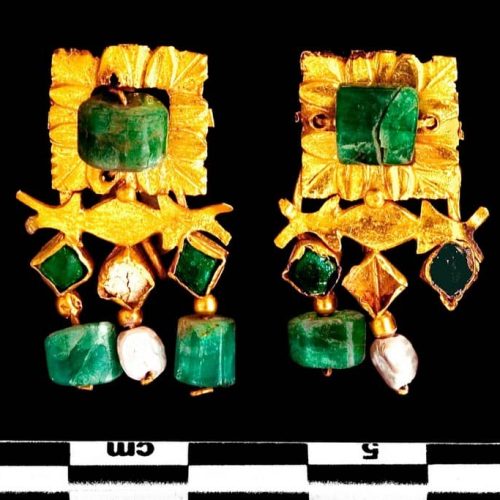
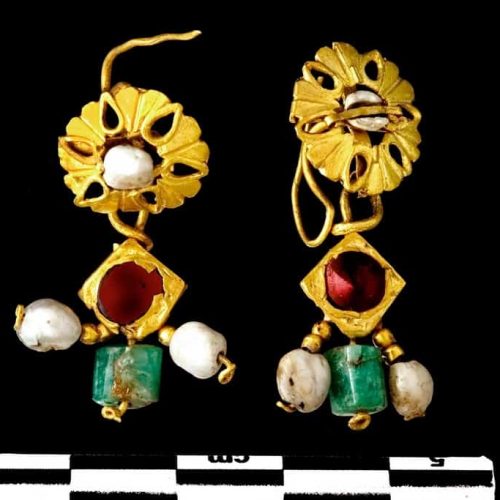
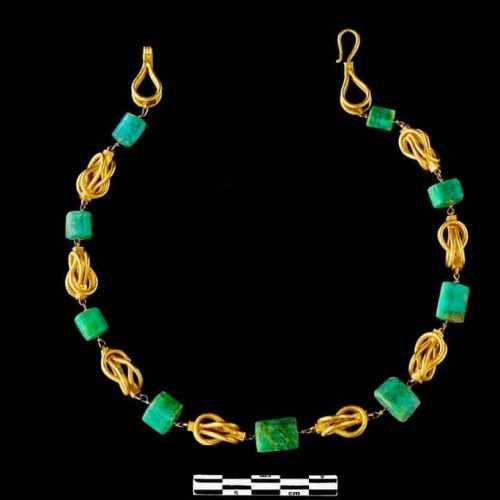
Identification of Possible Habachtal Emeralds
You should investigate further when you have a piece of emerald jewelry that meets one or more criteria of the following list: The investigation should be done by a gemologist, references that can be used to do that are publicly accessible via the net.
- Jewelry is of European origin and older than 1500, when the south American deposits were discovered by the Spaniards.
- Jewelry contains emerald gemstones that are polished flat cabochons. These pieces point to reused gallo roman gems.
- The blueish – green emerald itself shows a lot of cracks and inclusions, especially needle-like ones, and black flake.
- Jewelry is made in Great Britain or India and dates from 1860 to 1913, The most productive period of the mine. The emeralds were exported to India, and re-imported as “indian emeralds” because the mine was not yet known to many members of the industry.
As I am currently working on a book project on the Habachtal emerald deposit, I want to encourage you to report any suspected Habachtal emeralds for further scientific investigation to my email address: Habachtaler@gmail.com
If one of these criteria is met, a further investigation should be made by a gemologist. Remember, if a piece is proven to be of Austrian origin, the value of the piece is higher. Since Habachtal emeralds are collector objects and, especially in good qualities, very scarce.